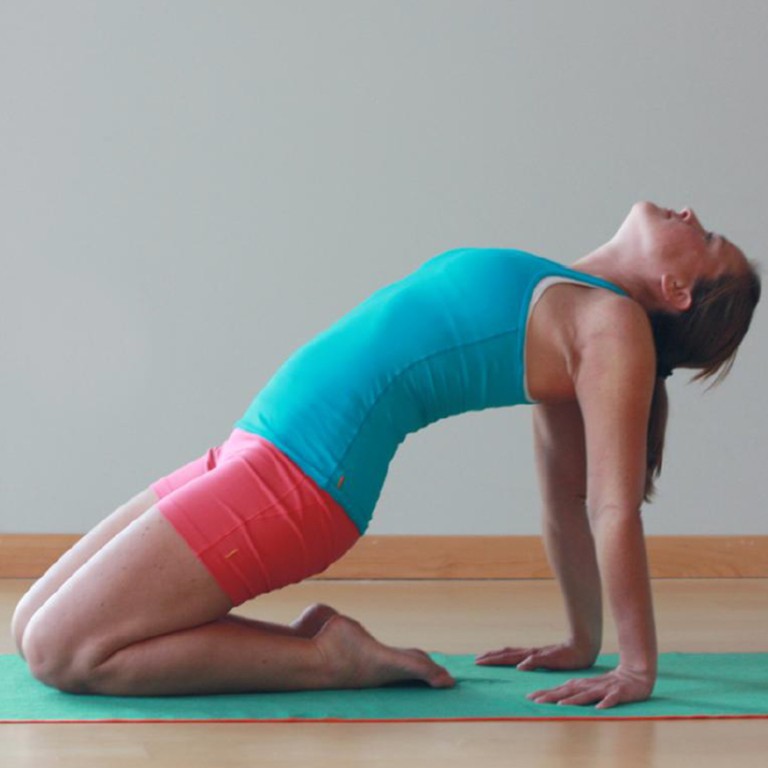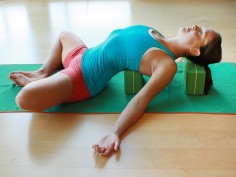
Yoga for cyclists can take some of the pain out of pedalling
Customised poses can help keep riders strong and flexible despite hours hunched over handlebars and perched on the saddle
Keeping a bicycle balanced and moving puts stresses and strains on the body that riders can prepare for, and recover from, with the right exercises.
As more people use bikes to commute, to exercise and to socialise, they may suffer more of the aches and pains that were considered par for the course when riding was occasional, but that kind of discomfort can become discouraging when a bike becomes transportation.
Biking, like running, is good aerobic exercise, says Bob Oppliger, a retired exercise science researcher at the University of Iowa, and it has the advantage of causing less stress on the joints.
“Physical activity in and of itself is good. Biking is particularly good for those who are overweight,” Oppliger says, but the static position of cycling can cost the body in lost strength and flexibility.

Hunched over the handlebars, perched on a narrow seat, pedalling constantly and holding up the head to watch the road can take a toll on muscles from the neck to the feet. Getting a bike that fits the rider’s frame and range of motion is important, but so is developing habits to restore the body after a strenuous workout and to build endurance for the next one.
Üma Kleppinger, who was a competitive cyclist and is taking up BMX racing as she’s about to turn 49, believes yoga adapted for the particular repetitive strains of cycling can keep riding fun and healthy.
“I wanted to help cyclists get to the heart of what’s beneficial to them,” says Kleppinger, who lives in Oregon. Her book BikeYoga offers a number of what she calls “stripped down” poses that if practised consistently can cultivate flexibility and strength.
It’s not yoga “for already bendy women”, she says, though some movements are similar to those in other forms of yoga. The poses are intended to counter the shortening and tightness in muscles and tendons that come with cycling and can cause discomfort, poor posture and shortness of breath.
“You’re sitting while cycling,” she says, “the worst possible position for the human body. Stress gets stored and those areas need to be opened up. The hips, lower back, shoulders and neck - the core strength brings it all together.”
The locust pose, for example, in which the chest and legs are lifted simultaneously, strengthens the back and tones the abdomen. Kleppinger says the sphinx, a kind of back bend with legs outstretched and arms flat with elbows under shoulders, helps keep the spine strong and flexible and boosts the nervous system.

The plank, in which the body is supported on the forearms and toes, is good for the core, arms and legs. The camel pose, where the body leans backward over bent legs and straight arms with fingers nearly touching toes on the floor, is particularly good to counter hunching.
Debbie Russo, who owns NEXT Yoga studio in Illinois and works with athletes of all ages and abilities, sees yoga as having an overall beneficial effect on the minds of cyclists as well as their bodies.
“Yoga increases strength, flexibility, focus and balance and can prevent injuries,” says Russo, who stumbled into a yoga class about 13 years ago as she struggled with Crohn’s disease, a chronic inflammation of the bowel.
Yoga works to lengthen the hip flexors for more fluid movement in pedalling and to lessen lower back pain, and it stretches the spine to combat rounding of the shoulders and tightness in the neck, she says, adding that emphasis on deep breathing and meditation helps with focus.
“It calms the central nervous system and lets you focus when needed, like when you’re close to another cyclist or about to turn a sharp corner,” she says.
Practising yoga “can prevent injury if you know what your body feels like on a good day”, she says.
Russo, like Kleppinger, believes the maximum benefit from yoga comes when a ride is over. A little stretching before is good so the muscles are not too tight, Russo says, but after being hunched over for a period of time, “it’s uber important to lengthen the spine and muscles for future rides”.
Kleppinger agrees. She says doing yoga after “makes a whole lot of sense because tissues are flush and saturated and ready to stretch”. She suggests about 20 minutes of targeted poses after a ride, and more general movements any time of the day to counter the sedentary nature of many jobs and activities.
The value of stretching is hard to quantify, Oppliger says, but the very nature of cycling causes parts of the body to fatigue.
“It’s probably more a feel-good type of deal. Any way we can think of to reduce stress is valuable,” he says.
